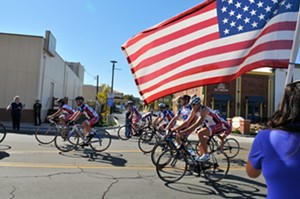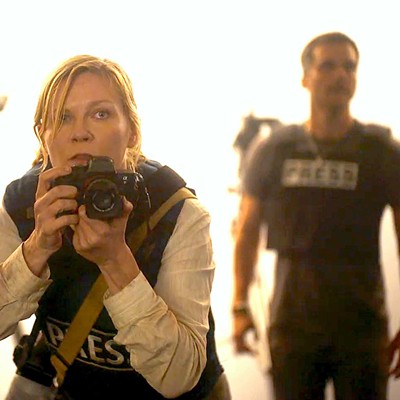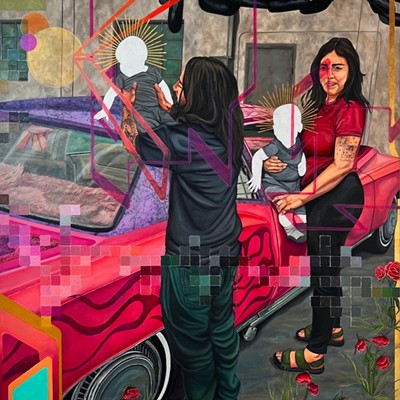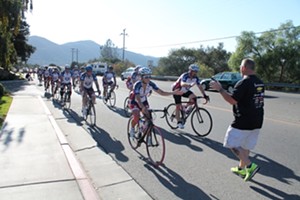
Watch a video of Ride 2 Recovery by Amy Asman
A voice shouts, “There they are!” People stop what they’re doing and move to the sidewalk, their toes close to the concrete edge, their eyes trained on the horizon.
The red-white-and-blue-clad cyclists move up the hill like a giant amoeba, the late afternoon sun bouncing off what looks like a collective bicycle helmet. As the group pedals closer, spectators begin to cheer.
“That’s how we do it, Delta Force!” one man exclaims as a woman close to him waves a small American flag.
Back in the saddle
The cyclists of Ride 2 Recovery rolled through the Central Coast Oct. 16 and 17, days four and five of their trip from the National Center for PTSD in Palo Alto to the Santa Monica Pier.
Launched in 2008, the nonprofit organizes and funds multi-day bike rides for soldiers and veterans recovering from mental and physical trauma.
Injured active-duty and retired personnel typically come to the organization on a doctor’s or a therapist’s recommendation. Ride 2 Recovery representative Debora Spano said cycling is an excellent rehabilitation activity because it’s so adaptable.
“It’s a very safe exercise for the body because it isn’t weight bearing,” she said.
It’s also something anyone can do.
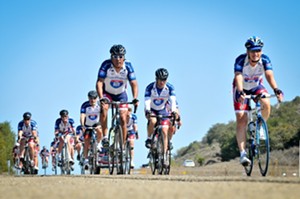
“We have one guy who is a double-arm amputee,” Spano said, explaining that the man’s bike is highly sensitive to touch, which enables him to shift gears with his legs and brake by sitting back on his seat.
“If they want to ride, we’ll make them a bike so they can ride,” she said.
Most Ride 2 Recovery newbies are introduced to the program through Project HERO, a collection of riding cadres throughout the country that offer training and support. Almost all of the Project HERO groups are tied to a military base or a Veterans’ Affairs hospital.
“[Soldiers] learn how to ride, they get fitted for a bike, and they learn how to care for themselves and their bikes,” Spano said.
The training helps them rebuild, physically and mentally. Once they’ve clocked some “time in the saddle,” she said, the new recruits are invited to join the Delta Force on one of the “challenge rides” staged throughout the United States.
“A lot of them have been laying in a transitional unit in a hospital or sitting in a dark room at home playing video games … and they’ve put on weight,” Spano said.
The rides are usually about 350 to 450 miles long. Each day starts around 9 a.m. with lunch around noon and dinner and relaxation at 6 p.m. United Healthcare and several other sponsors pay for the bikes, lodging, clothing, and helmets. United Service Organizations (USO) provides all of the food, and Ride 2 Recovery staffers take care of the bikes and luggage.
“The point is to make [the ride] as stress-free as possible,” Spano said. “This is a lifestyle change. These are rehabilitation rides; they’re not for fundraising or recreation.”
If the soldiers go on at least three rides, they get to keep a bike.
The recent California Challenge was Infantry Sgt. Eric Murray’s second ride. Prior to last month, Murray said, he “hadn’t been on a bike in 20 years.”
When asked why he decided to join Ride 2 Recovery, Murray said, “The camaraderie, the help that people want to give you, and the fact that I’m not up in here any more,” and pointed to his head.
The young sergeant was hit by two 155-millimeter rounds while serving in Iraq in 2006. The doctors managed to save his legs—he’s undergone more than 30 surgeries—but the pain was so bad, Murray said, he was “drinking a gallon and a half of Jack Daniel’s every night just to be able to sleep.”
But when he’s on the bike with his fellow servicemen and women, Murray doesn’t have time to think about the pain and everything else he’s been through.
“I just follow the Chevy,” he said, pointing to the car company’s emblem on the back of one of his fellow rider’s bike shorts.
The ride also helps heal what Spano called “invisible wounds.”
Monica Shoneff served until 2010 in the U.S. Army transporting, she said, “anything that needed to be moved,” including people, food, and ammunition. She now suffers from a traumatic brain injury, but she didn’t get it out in the field—she is a survivor of domestic violence experienced while serving in the military.
When she came home from the Army, she went back to school and juggled 20 college units and two jobs. She admitted to the Sun that she wasn’t in a good place in terms of health.
Then a Navy veteran from her school invited her to a Ride 2 Recovery event.
“I’d never been on a road bike, I didn’t know what I was doing, but I thought, ‘Why not?’” Shoneff recalled. “[On the ride] I had all these vets pulling up to me and teaching me things, and talking to me.”
She said she gets valuable peer-to-peer counseling on her bike.
“It’s a family here. It’s a safe place. I don’t have to isolate myself anymore,” she said.
Shoneff encouraged other soldiers to join the veteran community— through Ride 2 Recovery or another organization—to help them heal from their injuries, whether they were caused by artillery or sexual assault.
“Everything thing I’m struggling with, they’re struggling with, too, or they understand what I’m going through. I’m not alone,” she said.
Contact Managing Editor Amy Asman at [email protected].


